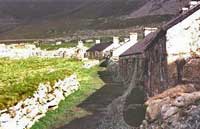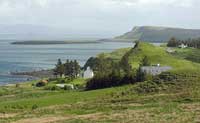Lady Grange - It would not happen now, would it?
Lord and Lady Grange lived at Niddry’s Wynd just off the High Street. They had been married some 20 years, when in 1730 Lord Grange demanded a divorce. This was opposed by Lady Grange. He claimed she was a nagging wife with a bad temper, she claimed he had suddenly grown tired of her. The settlement was £100pa on the condition that she move away.
 This worked for two years, but Lady Grange returned to live nearby, claiming that she wished to see her children. She also know much of the shady politics that Lord Grange had got himself mixed up in and had taken some documentary proof. (Lord Grange was the younger brother of the Earl of Mar who had difficulty deciding which side he was on during the Jacobite rebellion).
This worked for two years, but Lady Grange returned to live nearby, claiming that she wished to see her children. She also know much of the shady politics that Lord Grange had got himself mixed up in and had taken some documentary proof. (Lord Grange was the younger brother of the Earl of Mar who had difficulty deciding which side he was on during the Jacobite rebellion).
Lady Grange tried to use this knowledge to persuade Lord Grange to take her back, but it backfired rather badly, for Lord Grange persuaded his many political friends that she was dangerous and organised a long and convoluted kidnapping of his wife by a gang of Lord Lovat’s highlanders in January 1732.
 She was taken, often by night, to various safe houses until in August she came to the West coast where she was transported to the island of Heskir. She stayed with one family there for nearly two years, then she was transported to St Kilda where she was kept until 1741. During all this time she tried every means to get messages back to friends in Edinburgh, but to no avail. No one spoke English and the Chief’s orders were always obeyed.
She was taken, often by night, to various safe houses until in August she came to the West coast where she was transported to the island of Heskir. She stayed with one family there for nearly two years, then she was transported to St Kilda where she was kept until 1741. During all this time she tried every means to get messages back to friends in Edinburgh, but to no avail. No one spoke English and the Chief’s orders were always obeyed.
In 1741 the Minister fell out with the Chief and returned to the mainland. He brought her story back to Edinburgh where it evoked much sympathy and the matter went to court. Lord Grange opposed her release, saying it was in her own interest to stay away, but he lost. Mr Hope of Rankeillor, Lady Grange’s legal agent, tried to send a boat to rescue her, but it had barely left Oban before news was brought that she had been removed to Skye.
 By this time the ’45 rebellion was under way and no attempt was made to further her case. However her years of captivity had taken its toll on her health and she died in Skye in 1745. She is buried at Trotternish at the north end of the island.
By this time the ’45 rebellion was under way and no attempt was made to further her case. However her years of captivity had taken its toll on her health and she died in Skye in 1745. She is buried at Trotternish at the north end of the island.
Source - Traditions of Edinburgh by Robert Chambers
The following links may be of interest. From the society of antiquaries archive
One of the letters of the settlement
A letter from St Kilda
The story around the letter
